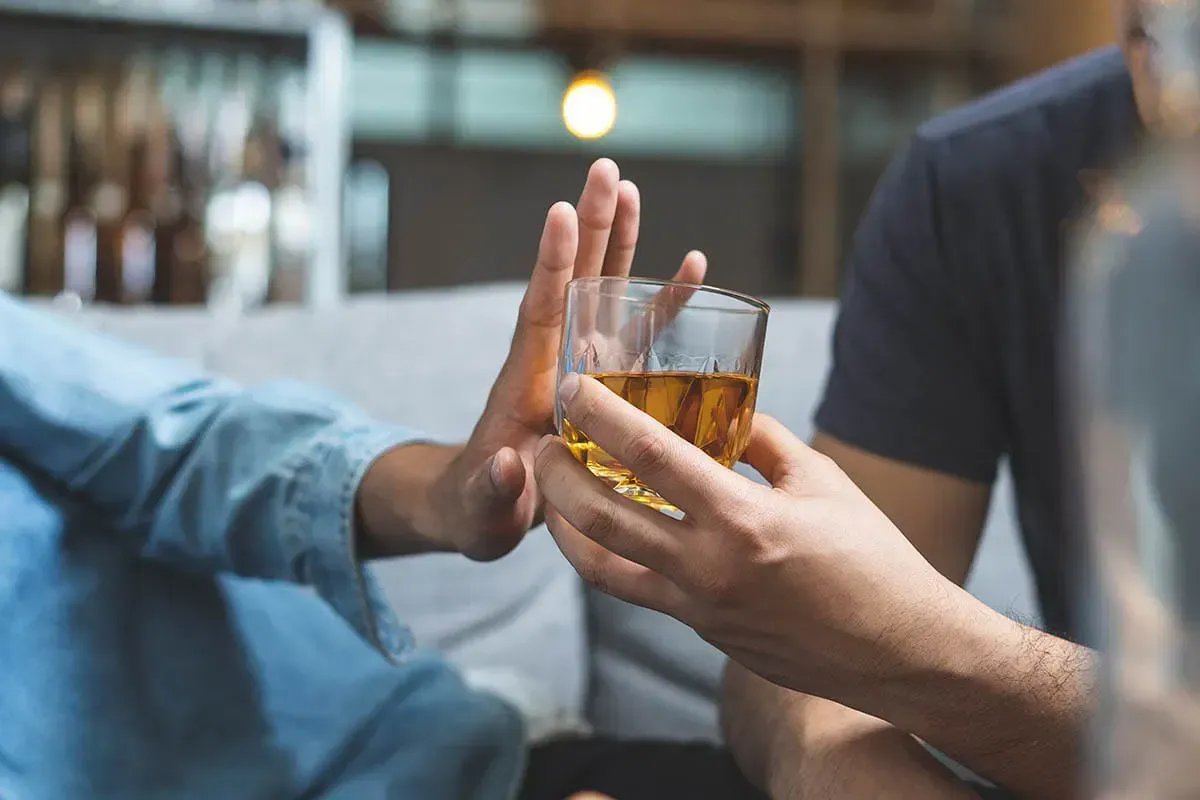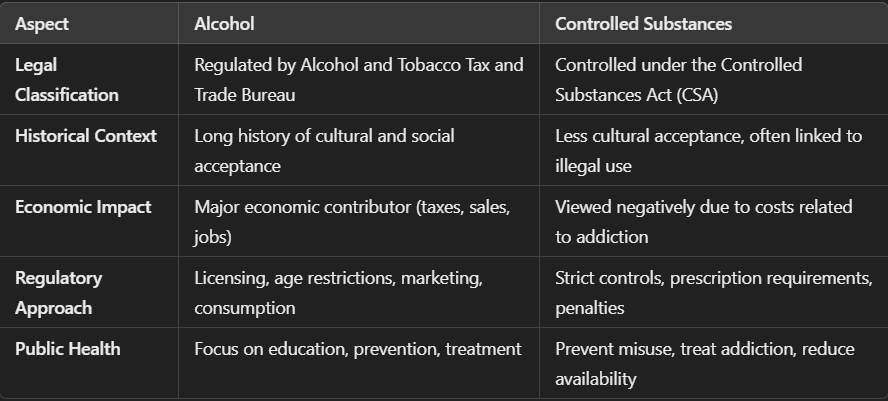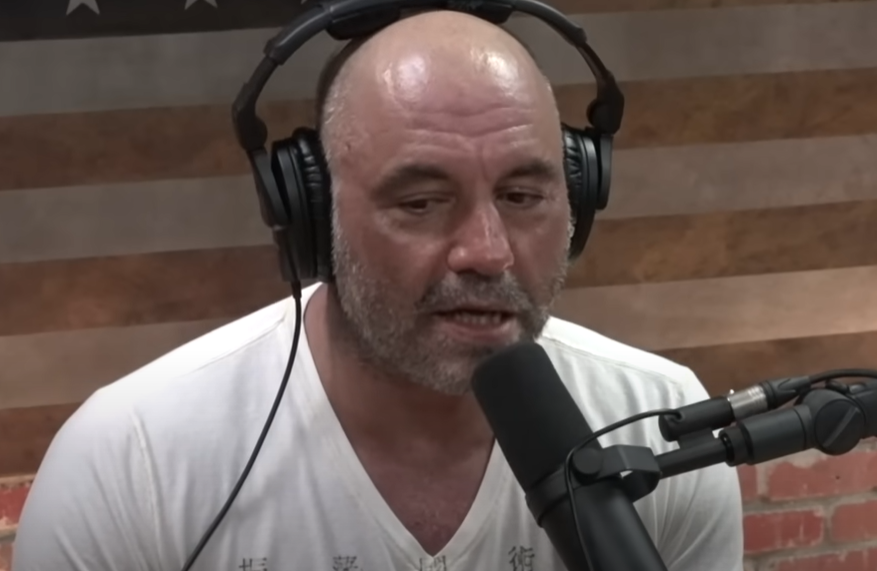No, alcohol is not classified as a controlled substance in the United States. However, this does not mean it is unregulated; here at Orange County Drug & Alcohol Rehab Center, tailored solutions for alcohol addiction are offered. The federal government strictly oversees its production, distribution, and sale. This is due to its potential for misuse and serious health risks.
Chronic heavy drinking is a major risk factor for liver diseases such as cirrhosis, with the CDC reporting that alcohol-related liver disease was responsible for 49.5% of all cirrhosis deaths in 2019. These risks cause stringent regulations to limit the negative impact on individual and public health.

85.6% of people aged 18 or older reported that they drank alcohol at some point in their lifetime. In addition, the National Institute on Alcohol Abuse and Alcoholism (NIAAA) notes that 25.8% of adults reported binge drinking in the past month, highlighting the prevalence of excessive alcohol consumption.
The health effects of alcohol consumption can be severe. Even short-term excessive drinking can lead to accidents, injuries, and violent behavior. According to the Centers for Disease Control and Prevention (CDC), alcohol is involved in about 30% of all fatal car accidents in the United States. All this while long-term misuse increases the risk of chronic diseases.
The World Health Organization (WHO) states that alcohol is responsible for 3 million deaths globally each year. This represents 5.3% of all deaths. Furthermore, alcohol consumption is a causal factor in more than 200 disease and injury conditions, according to the WHO. Despite this, it's not considered a controlled substance. The economic cost of excessive alcohol consumption in the U.S. was estimated at $249 billion in 2010, with the majority of costs due to losses in workplace productivity, healthcare expenses, law enforcement, and other criminal justice costs.

One redditor asked why alcohol is not a controlled substance. This guy answered that it had once happened in America. However, he mentioned that crimes increased, and it was more unsafe. He stated that prohibition “does not work”.
While people often compare alcohol to other regulated substances, its legal status remains unique. Unlike controlled substances in the Controlled Substances Act, alcohol's regulation is different. They address its specific challenges and widespread consumption. This legal framework ensures that while alcohol is accessible, its potential for abuse is monitored.
Why is Alcohol not a Controlled Substance?
Alcohol is not classified as a controlled substance mainly because of its historical and cultural acceptance. Despite its potential for abuse and health risks, here’s are more key reasons why it isn’t:
Historical and Cultural Acceptance - Alcohol has been widely used and accepted in many cultures for centuries. This long history of use has contributed to its legal status and societal acceptance.
Economic Impact - The alcohol industry is a significant economic contributor. They generate substantial revenue through taxes, sales, and employment. Prohibiting alcohol would have considerable economic repercussions.
Regulatory Framework - It is not under the Controlled Substances Act. Alcohol is regulated by other laws, such as the Alcohol and Tobacco Tax and Trade Bureau (TTB) regulations.
Social Norms and Integration - Alcohol consumption is integrated into social norms and activities. Activities such as celebrations, dining, and religious ceremonies. Its regulation is therefore managed to allow for these social contexts rather than treating it solely as a substance of abuse.
Public Health Approach - Alcohol-related issues often involve health initiatives rather than criminalization. Efforts focus on education, prevention, and treatment for alcohol abuse and dependence.
Prohibition Experience - The United States' experience with alcohol prohibition is an example. In the early 20th century, it showed extreme challenges. This includes the rise of illegal alcohol production and distribution. It also spiked organized crime and public resistance. The failure of Prohibition influenced the decision to regulate rather than ban alcohol.
What are Controlled Substances?
Controlled substances are drugs or chemicals that are regulated by the government. This is particularly due to their potential for abuse and dependency.
Controlled Substances Act Overview
The Controlled Substances Act (CSA) was enacted in 1970 to regulate the distribution, production, and use of certain drugs. The law categorizes drugs into five schedules. These are ranked based on their medical use, potential for abuse, and safety or dependence liability. The Drug Enforcement Administration (DEA) oversees this framework.
Comparing Alcohol to Scheduled Substances
Alcohol is not classified under these schedules. This is despite being a psychoactive substance that can cause dependence. Its exclusion from the CSA highlights historical, cultural, and economic factors. Those reasons make it different from other regulated substances. Alcohol's production, sale, and distribution are heavily regulated but not by the schedules in the CSA. This unique position is partially a result of the Prohibition era in the 1920s, which attempted and ultimately failed to ban alcohol.
While alcohol shares some risks with controlled substances, regulations around it are different. This is due to its long-standing social acceptance and widespread use.
Controlled Substance List
A controlled substance is regulated by the government due to its potential for abuse or addiction. These substances are categorized into five different schedules. All of these are under the Controlled Substances Act (CSA).
Schedule I:
- No accepted medical use
- High potential for abuse
- Examples: Heroin, LSD, Marijuana
Schedule II:
- High potential for abuse with severe psychological or physical dependence
- Accepted medical use
- Examples: Hydromorphone (Dilaudid), Methadone (Dolophine), Oxycodone
Schedule III:
- Moderate to low potential for physical and psychological dependence
- Accepted medical use
- Examples: Codeine, Anabolic Steroids
Schedule IV:
- Low potential for abuse and low risk of dependence
- Accepted medical use
- Examples: Alprazolam (Xanax), Diazepam (Valium)
Schedule V:
- Lower potential for abuse than Schedule IV. It consists of preparations containing limited quantities of certain narcotics
- Accepted medical use
- Examples: Cough preparations with less than 200 milligrams of codeine per 100 milliliters or per 100 grams
Alcohol Versus Controlled Substances
When comparing alcohol to controlled substances, several distinctions emerge. This encompasses legal, societal, and regulatory aspects. Here are the key differences:

Joe Rogan Talks About Why a Drug Like Alcohol Get a Pass

In an episode of "The Joe Rogan Experience," Joe Rogan is joined by Malcolm Gladwell. They discussed the societal perception of various substances. Mainly focusing on alcohol, cigarettes, and marijuana. They agree that the current social norms are upside down. This is with alcohol being the least taboo despite causing significant social harm.
Joe Rogan's Issue with Alcohol
Rogan and Gladwell argue that alcohol should be the most taboo substance due to its extensive negative impact on society. Rogan recounts personal experiences with cigarettes and marijuana. He expresses his belief that while cigarettes provide a fleeting head rush, they are ultimately destructive. He contrasts this with his view on marijuana. Which he believes can have beneficial effects on consciousness and sociability.
How He Views Alcohol
Rogan reflects on his own use of alcohol, acknowledging that he enjoys it occasionally. However, he remains aware of its potential for addiction and social harm. He expresses concern about young people developing alcohol problems. He also mentions friends who have struggled with alcoholism. Rogan is cautious about glorifying alcohol, given the significant issues it can cause for some individuals.
The Social Impact of Alcohol
Malcolm Gladwell highlights the disproportionate social damage caused by alcohol. Especially when compared to other substances like cigarettes. He points out the paradox in societal attitudes. Where being associated with tobacco companies is heavily frowned upon. All while involvement with alcohol companies is often seen as acceptable or even prestigious. Gladwell is puzzled by how society has come to accept alcohol. This is despite its significant social and health-related consequences.
How Alcohol is Perceived in Society
Gladwell and Rogan discuss the widespread acceptance of alcohol advertising. This is especially in environments like college campuses. They note the irony of colleges partnering with alcohol brands. Given the substantial problems alcohol can create for young people.
What is the Phase Four of the Intensive Outpatient Counseling Program at Orange County Drug & Alcohol Rehab Center?
Phase Four of our drug treatment program entails an intensive outpatient counseling program. As you begin to feel more like yourself again without substances, you’ll need to go through an outpatient program. Especially one that will help you get to the root of your addiction.
To learn more about our outpatient counseling program and how you or a loved one can become admitted into our drug treatment program, reach out to us.
What To Expect With Phase Four Of Our Drug Treatment Program
In Phase Four, you will begin to learn how you can live a life without drugs and alcohol. While the previous phases detailed detoxing your body and your mind from substances, in Phase Four, we’ll help you with those mental hurdles. Add those unresolved emotions that you might be struggling to overcome.
We’ll help you break free of those constraints as well as help you achieve a better awareness of your own happiness with your life. When you enter Phase Four, you’ll work with a chemical dependency counselor who can help you learn how to live in the present.
How Does Phase Four Work?
Phase Four is the final step of our drug treatment program. As we enter Phase Four, you’ll start a unique form of therapy. One that will help you handle any type of mental state you might find yourself in whether it’s an easy or a hard day.
Our philosophy at Orange County Drug & Alcohol Rehab Center is based on drug and alcohol counseling needs to dive into an individual’s past. This is to fully understand what has drawn them to drugs in the first place. The negative emotions that someone might exhibit is what drives a person to want to become happier with substances. We’ll help you look toward a future that is healthier and happy with the help of a trained professional.
Why You Should Select Orange County Drug & Alcohol Rehab Center
Located in California, Orange County Drug & Alcohol Rehab Center is a premier facility dedicated to guiding you towards long-term recovery. As a family-owned center, we pride ourselves on offering a unique rehabilitation experience. We address both physical and mental addiction. Our four-phase drug treatment program is designed to help you achieve a healthier and happier life free from substances.
Why Choose Us:
- Family Owned - We offer a personal touch and a compassionate approach to your recovery journey.
- PhD Level Clinical Director - Our program is overseen by an expert with a doctoral level of expertise.
- Masters Level Therapists Specialized in PTSD and Trauma - Our therapists are specialized in treating PTSD and trauma. This ensures comprehensive care.
- State Licensed and Joint Commission Accredited - We meet the highest standards of care and safety, giving you peace of mind.
- Legitscript Certified - Our certification assures that our practices meet the rigorous standards. Both legitimacy and quality in addiction treatment.
Choose Orange County Drug & Alcohol Rehab Center for a supportive, professional, and accredited path to a substance-free life.
It's important to note that these costs can vary significantly. Some rehab centers offer sliding scale fees based on income. Many accept insurance, which can help reduce out-of-pocket expenses. Other payment options include financial aid, grants, or payment plans.
